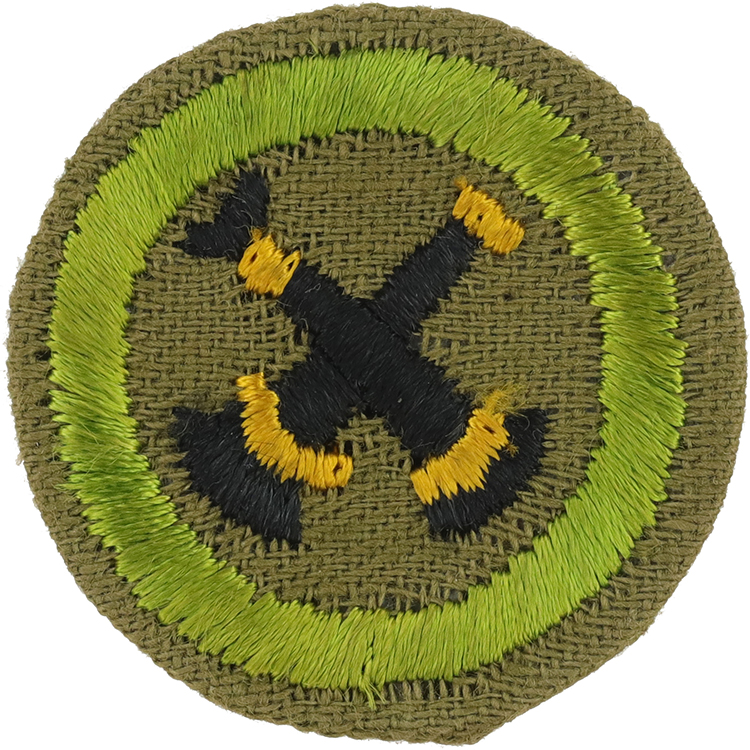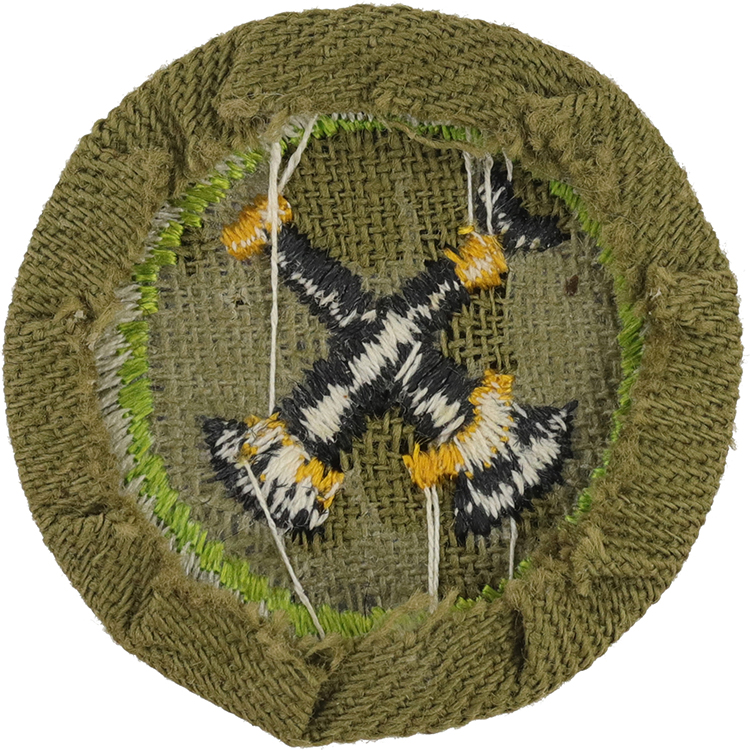
Fig. 1: Firema-D4-Front
- Cloth: War
- Embroidery: Cotton lock stitch

Fig. 2: Firema-D4-Reverse
- Back: Plain NO imprint with starch
Item Name: Firemanship 1942 - 1945
Item ID: Firema-D4
Collector Rating: 1
Requirements July 1933 until September 1945
1. Describe in his own words, the contrast between fire as man's servant (under control), and that same fire as man's enemy (beyond control). From actual incidents, of which he knows personally or has read, describe the loss and other harm which resulted from lack of proper fire protection both in the case of a home and a community. Give statistics indicating the average yearly loss of life and property due to fire.
2. Demonstrate or submit sketches illustrating two of the following:
(a) Proper building of camp fire with relation to inflammable material both around and under place where fire is laid;
(b) How to extinguish a camp fire;
(c) Three practical methods of forest fire prevention;
(d) Three simple methods of forest fire fighting where elaborate equipment is not available.
3. (a) Give three most common causes of fire in the home, other than careless use and storage of gasoline, and tell how each may be guarded against or prevented.
(b) What precautions should be taken for safe use and storage of gasoline and other inflammable liquids.
(c) Submit practical plan of action for the safe escape of the whole household, including himself in case of fire at night; such plan to include:
(1) Diagram of the floors on which family sleeps and of the floors below, if any;
(2) Details of how he would rouse the family and direct their escape;
(3) List of fire protection equipment necessary in his home, depending upon whether he lives in urban or rural community.
4. Personally conduct at least one fire drill in his Troop meeting place.
5. Demonstrate:
(a) How to light and discard a match safely;
(b) With another Scout as subject, what to do in case latter's clothes become ignited, both where blanket or rug is available, and where no such aid is available;
(c) With several other Scouts, formation of a "bucket brigade";
(d) How to make a satisfactory fire pail from a No. 10 can;
(e) What he would do if caught in a room filled with chemical fumes or smoke;
(f) How to extinguish fire under hood of automobile.
6. Explain:
(a) At least two causes which are likely to result in spontaneous combustion and how it may be prevented in each case;
(b) Three ways of turning in a fire alarm, citing best local method and giving exact location of nearest fire alarm to his home, Troop meeting place, and place of employment or school;
(c) Principles underlying at least three common types of fire extinguishers and how to operate each;
(d) Precautions and measures he would take to rescue animals from a burning stable.
Requirements 1945 until January 1957
1. Explain three common causes of fire in the home (other than careless use of gasoline and kerosene) and tell how to guard against each.
2. (a) Inspect his home, fill out an inspection blank, and present it to the Counselor; (b) tell how he would plan, in case of fire at night, for every one in his home, including himself, to escape to safety; (c) list the equipment and material in his home available for fire protection and explain under what conditions each is used; (d) tell what fire fighting forces would respond to a fire alarm from his home.
3. Tell where flammable liquids such as gasoline, kerosene, and turpentine should be stored for absolute safety and under what conditions only they should be used.
4. Explain at least two causes of spontaneous ignition and tell how to guard against them.
5. (a) Light a match safety and discard it safely; (b) make a satisfactory fire pail from a gallon or No. 10 can, or make a fire beater or fire rake; (c) show what to do if caught in a room filled with dense smoke or chemical fumes; (d) give three ways of turning in a local fire alarm; tell exact location of nearest fire alarm to his home, school and Troop Meeting Room.
6. Show two steps necessary to save a person whose clothes are on fire.
7. Using proper methods: (a) build a fire in the open where there is flammable material both around and under place where fire is to be laid; (b) extinguish this fire.
8. (a) Tell how to select, prepare and maintain a camp site so that proper fire prevention will be provided at all times; (b) explain three simple ways of fighting a forest fire when fire fighting equipment is no available, and how to use three simple hand tools in fighting the fire; (c) tell whom he should notify in case of a serious fire on camping trips during the year.
9. Conduct a fire drill in his Troop.
10. Explain what his Scout Troop or Patrol can do to help the local fire fighting organization or the community prevention campaign.



